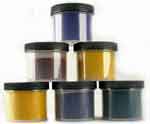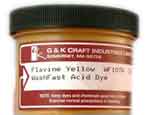Correcting problems with black acid dye
Name: Frank C
—ADVERTISEMENTS—

Lanaset Dyes are among the very best dyes for hand-dyeing wool, silk, angora, mohair, and most nylons. You will also need: citric acid, sodium acetate, Glauber salt, Albegal SET, and Synthrapol.
Buy from
Paradise Fibers
Washfast Acid dyes
at Paradise Fibers

Washfast Acid dyes
Also known as Nylomine dyes, excellent for use on nylon. One ounce of dye will dye six pounds of fiber!
at Paradise Fibers

Washfast Acid dyes
Also known as Nylomine dyes, excellent for use on nylon. One ounce of dye will dye six pounds of fiber!

Linda Knutson's
Synthetic Dyes for Natural Fibers
An ideal introduction to how to use synthetic dyes.

Color for Science, Art and Technology, Volume 1, edited by Kurt Nassau
This technical book explains many features of modern dye chemistry.

Country or region: USA
Message: Hiya,
I've actually come across your site a few times and I haven't really came across this issue from the topics you've discussed so I figured I'll try to bring it up to you directly and ask your opinion or experience on this:
Friends of mine and I are trying to dye a bunch of nylon with acid dye using a stovetop method. All our acid dyes so far have been Dharma's brand, and using synthrapol to wash before dyeing and after to rinse out the excess dye. Caribbean blue came out awesome, but we tried the True Black recently and it came out greyish-purple after drying. I wasn't sure if it was the dye, the nylon, or if getting a true black requires more than one dyeing round. One friend said she spoke to other dyers and they suggested dyeing a dark base color first like purple or brown and then black over it to get a true black, but that to me seems a bit odd, and in which case I don't see why we couldn't just dye using the black dye first, and then black dye again over it. Anyway, just wanted to ask if you've ever run into this issue and if you have had any luck getting an actual black dye. I'm going to try getting Jacquard's Jet Black acid dye next order to see if it turns out better, but meanwhile, I wanted to seek your advice on the issue. One of the friends also thought that pre-washing in synthrapol (since it contains alcohol) could have affected the effectiveness of the black dye if there were remnants in the fabric when it was put in the dye bath, but the Dharma rep I emailed didn't think it would affect anything. Anyway, thanks in advance if you happen to have any advice for this.
The most likely cause of your black problem is simply not using enough dye. It's very common, no matter what you are dyeing or what type of dye you are using, to get an off color, purplish or greenish or bluish or brownish, when what you want is a true black. This may be caused by using the wrong dye application recipe, or making some mistake, or to something wrong with the fiber you were dyeing, but usually it is caused by simply failing to use enough dye. Black is so much darker than any other color that you have to use a lot more dye!
How much dye powder did you use, compared to the weight of your nylon before you got it wet? Although all other colors require far less dye, Dharma says that their #413 True Black acid dye requires a huge 4% of the weight of goods you are dyeing! This is generally true for all black acid dyes, of any brand. For most acid dye colors, 1% of the weight of your fiber will be sufficient. For example, if you have a piece of nylon fabric that weighs 100 grams (a little less than a quarter of a pound), you would normally need only one or possibly two grams of dye powder to color it, or much less for a pale color, but you will need four grams of the black dye powder for that much nylon.
Quantity of dye is not the only possible issue. Different fibers will produce different colors in a given dye. A dye that makes a perfect black on wool might be slightly off-color on nylon, for example. Different acid dyes have very different properties from one another. (How many times can I use the word "different" in one paragraph?)
I don't think that traces of Synthrapol are at all likely to cause this sort of problem in acid dyeing. Many acid dyeing recipes call for Synthrapol or a similar product to be added to the dyebath itself, not just for prewashing, in order to aid in wetting the fiber, so that the dye can penetrate well. The tiny amount of alcohol in Synthrapol shouldn't do anything significant.
I really like the way Dharma lists information about each of their acid dyes. Caribbean Blue is a leveling acid dye, with the generic name of Colour Index acid blue 7, which means that it produces a very even, non-splotchy color, but it has relatively poor wetfastness, so you must take care in the laundry ever afterwards. (See my page about Leveling Acid Dyes.) This particular acid dye also has poor lightfastness, so do not line-dry it in the sunshine; always dry it indoors, if you wash it yourself, or use dry-cleaning. (See my page, "Lightfastness of Different Types of Dyes".)
Dharma's True Black acid dye, in contrast, is a premetalized dye, generic name Colour Index acid black 194, from a group of dyes that is on the opposite extreme of Leveling Acid dyes. Premetalized dyes are less good at leveling, so to get a perfectly smooth color you often add a leveling agent as called for by the recipe, but they have dramatically superior washfastness. While a leveling acid dye is likely to bleed out some even in cool water, and possibly wash out altogether in hot water, a premetalized acid dye is highly resistant to washing out, and may be able to survive being washed with even hot water, depending on the specific dye and how well it was applied. It's really a superior type of dye. Premetalized acid dyes require a higher optimal pH than the leveling acid dyes (which are also known as "strong acid dyes"), closer to a neutral pH, which means they need less acid; they are also a little more difficult to apply correctly. You may get better results by using ammonium sulfate instead of the vinegar or citric acid you might use with a leveling acid dye. It really doesn't make sense to follow the exact same recipe for dyeing with a premetalized acid dye as you would use for a leveling acid dye, given that they have such different requirements for pH. (See the chart on my page, "What is the effect of pH in dyeing? What is the optimal pH?".)
It won't hurt for you to try a different dye, though I suspect that Dharma's True Black will work perfectly well for you with some adjustment of quantities and, if necessary, tweaking of the recipe. Jacquard's Acid Black is not likely to be superior to Dharma's True Black. Unlike Dharma's True Black, Jacquard's Acid Black is a mixture of more than one color of dye, which means that it is more likely to separate out into different colors on the fiber itself, if you allow that to happen. As with Dharma's black acid dye, large quantities are essential. Jacquard Products recommends that you use three whole ounces (that's 85 grams) of their 639 Black acid dye to color just one pound of fabric or yarn! That would be six of the smallest (15 gram) jars of Jacquard Acid Dye, if you're buying them in that form, which would be an expensive way to do it, though the larger jars provide a much better deal. Be sure that you weigh whatever you are dyeing, while it is dry, and make certain that you are ordering a large enough quantity of dye!
A couple of other very popular black acid dyes are the Lanaset Jet Black and the Washfast Acid Jet Black. The latter contains Colour Index acid black 172, while the former contains a mixture of Colour Index acid black 172 with another black acid dye that does not have a Colour Index generic name. (See my Dye Forum post, "Lanaset Jet Black contains Washfast Acid Jet Black WF672 plus another black dye".) In the US, both classes of dye are sold by PRO Chemical & Dye and by Paradise Fibers; Lanaset dyes are also sold by Earth Guild. These two dyes, the Lanaset Jet Black and the Washfast Acid Jet Black, are the most-frequently recommended of the black acid dyes, in my experience. Since they are premetalized acid dyes, I would expect them to perform similarly to Dharma's, with some differences since the dye molecules are not the same. However, the special additive sold for use with the Lanaset dyes, Albegal SET, will improve leveling. You will probably get your very best black by using the Lanaset black and following PRO Chemical & Dye's instructions for "Immersion Dyeing using Lanaset/Sabraset Dyes". [PDF]
(Please help support this web site. Thank you.)
(Please help support this web site. Thank you.)
Posted: Friday - September 23, 2011 at 11:15 AM
Follow this blog on twitter here.
Quick Links
- All About Dyes & Dyeing Top -
- Top of this blog -
- FAQ -
- The Dye Forum -
- How to Tie Dye - How to Batik -
- Books - Toys - Plants -
- Top of this blog -
- FAQ -
- The Dye Forum -
- How to Tie Dye - How to Batik -
- Books - Toys - Plants -
More in this category:
- -
Statistics
Total entries in this blog:
Total entries in this category:
Published On: Aug 29, 2012 02:49 PM
Total entries in this category:
Published On: Aug 29, 2012 02:49 PM